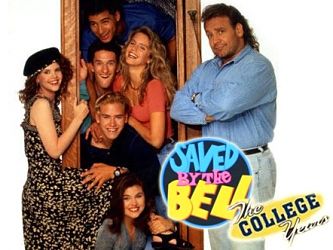Popular media portrayals of higher education play a powerful role in influencing perceptions of college. Movies and television shows set expectations for people that may never review an institutional report, visit our web site, or read our marketing materials. As faculty and administrators in higher education, we need to recognize these trends are all around us. Let’s take for example that great 90’s classic, Saved by the Bell: The College Years.

Saved by the Bell was a television show airing in the early 1990’s focusing on a group of high school students and their exploits. Following the high school version, a college sequel aired for one year in primetime following some of the students to Cal U (loosely based on Cal-Berkeley).
Higher education plays a role in many popular television shows such a The Big Bang Theory and, of course, Community. Given its nature, none may have hit on as many stereotypes as Saved by the Bell: The College Years.
Just think about a few of the characters:
Zack Morris: The popular schemer who always looked for the quick win and stayed one step ahead of the authority figure in the show. Zack constantly sought the affections of the attractive cheerleader, Kelly. In a typical scene, Zack complains about all the reading required in college and wants to watch a movie version of his textbooks.
Kelly Kapowski: The popular cheerleader and love interest for Zack. At the end of the high school version of the show, Kelly announced she didn’t have the money for an out-of-state school and would attend community college. However, she ends up at Cal U for the sequel. In college, Kelly has a relationship with one of her professors before she ultimately reunites with Zack.
Dean Susan McMann: As dean of students, McMann plays the central authority figure role. She has a strong dislike for Zack and attempts to thwart his various schemes.
Mike Rogers: Played by former football player Bob Golic, Rogers serves as the live on residence life advisor. Rogers serves as a kind of coach and authority figure for the students.
There are three narratives from Saved by the Bell: The College Years that we should be mindful of as faculty and staff.
1. College is simply a continuation of high school. The entire premise of the show is built around this idea. While every high school surely doesn’t resemble Bayside High, many first-year students often assume college is an extension of high school with a little more freedom. We know that college is different both academically and socially. We should remind our students of the differences in college expectations to help them transition and succeed.
2. Student affairs replaces the role of the principal. When the show transitioned to college, the authority figure and “grown-up” moved from the principal to student affairs staff. From the Dean of Students to resident advisor, student affairs played the role of keeping check on the exploits of the gang. Many students see this as the primary function of student affairs particularly in areas such as Greek Life and conduct. Without specific effort, it is easy to fall into this routine. Student affairs professionals must continually seek out a posture dedicated to holistic student development and avoid playing the role of the television principal.
3. Central role of the residence hall. In the high school version, one of the most contrived parts of the show was how much had to take place at school. In The College Years, the residence hall became the central location of the show. I will admit as a faculty member that I don’t often think about the central role that residence life plays on campus (at least those with a residential component). As living-learning communities and faculty-in-residence programs demonstrate, the residence hall can be a powerful place to interact and engage with students. Everyone on campus should take better advantage of our on-campus population to provide services, programs, and opportunities that will improve the education of our students.
While movies and television shows about higher education may not resemble a real college, these narratives do impact how students perceive the higher education experience.
Last year, I met a group of European high school students and was struck by the role of movies and television on their perceptions of American higher education. Of course, the same holds true for American students as well.
All of us in higher education should think critically about how we are portrayed in movies and television. These shows in direct and subtle ways help set expectations for our students. As a result, they have a clear impact on the work of teaching and student development that we do every day.

